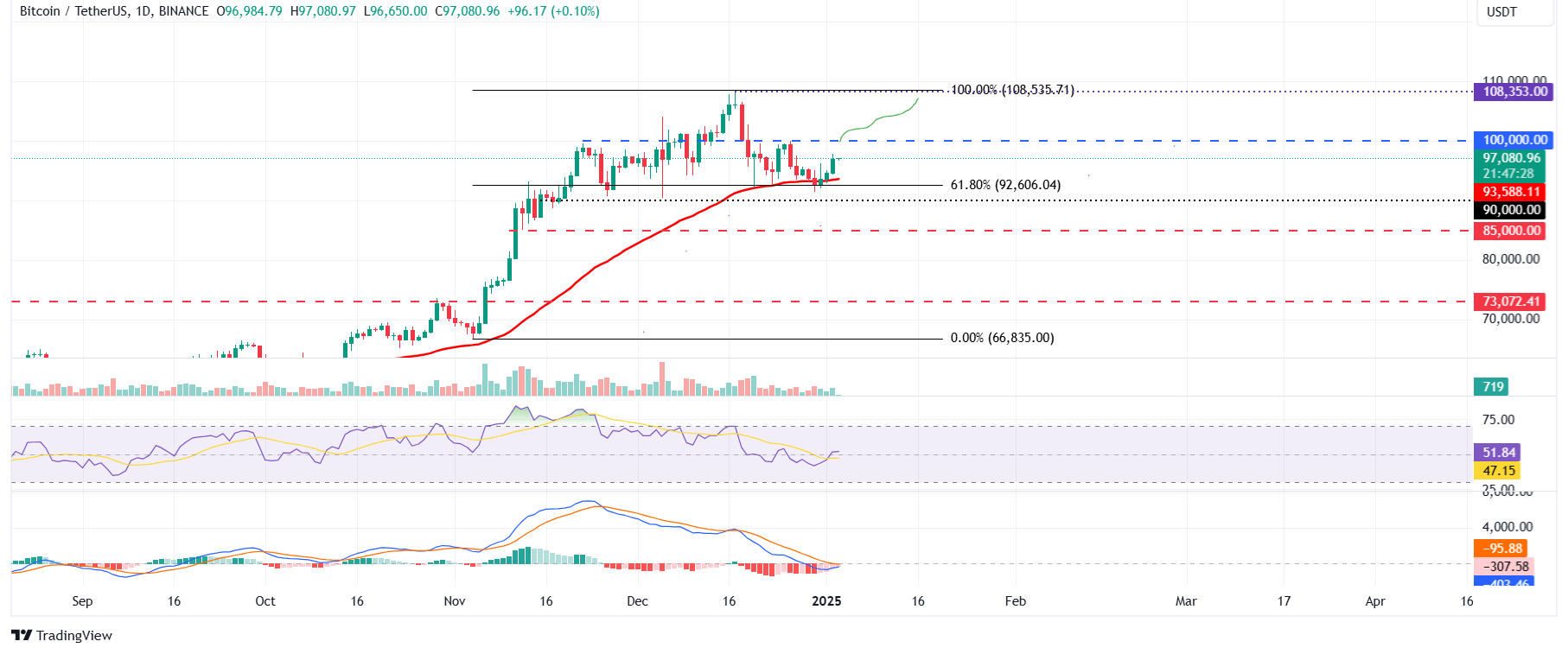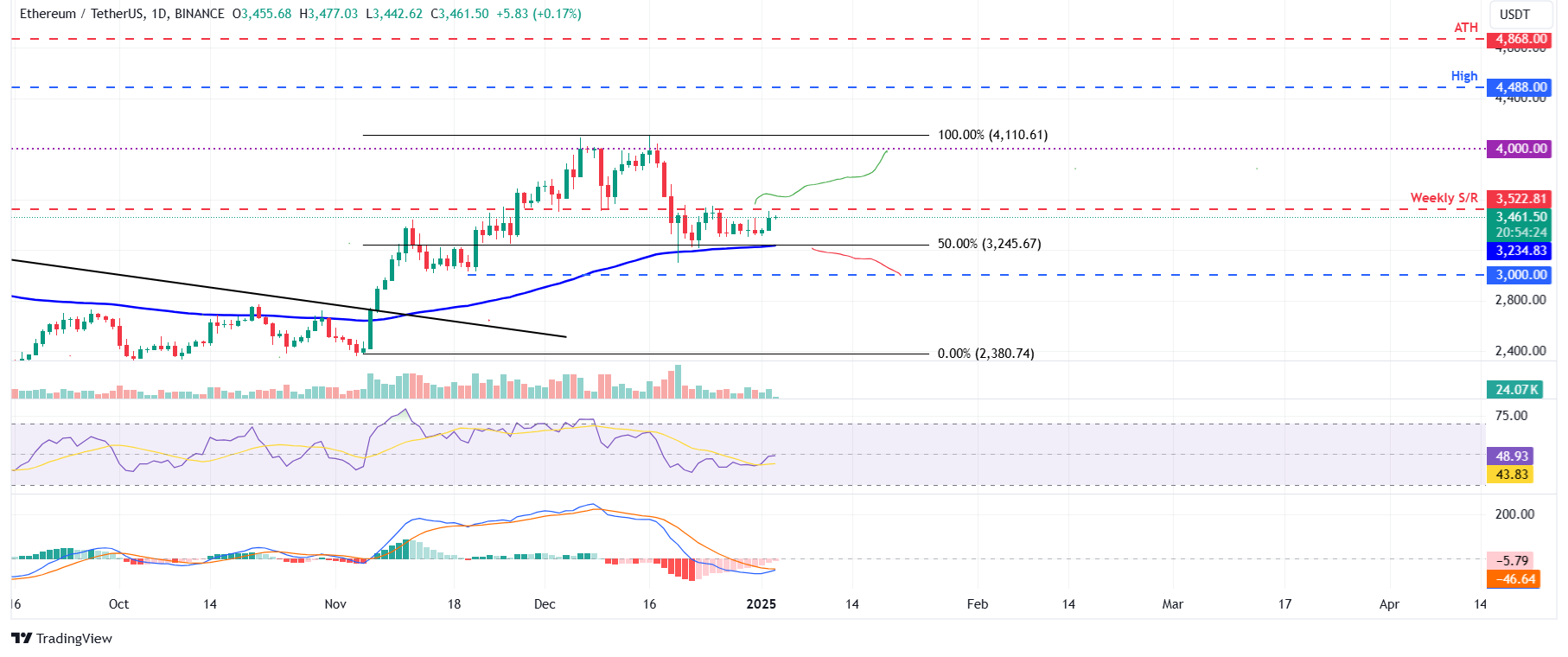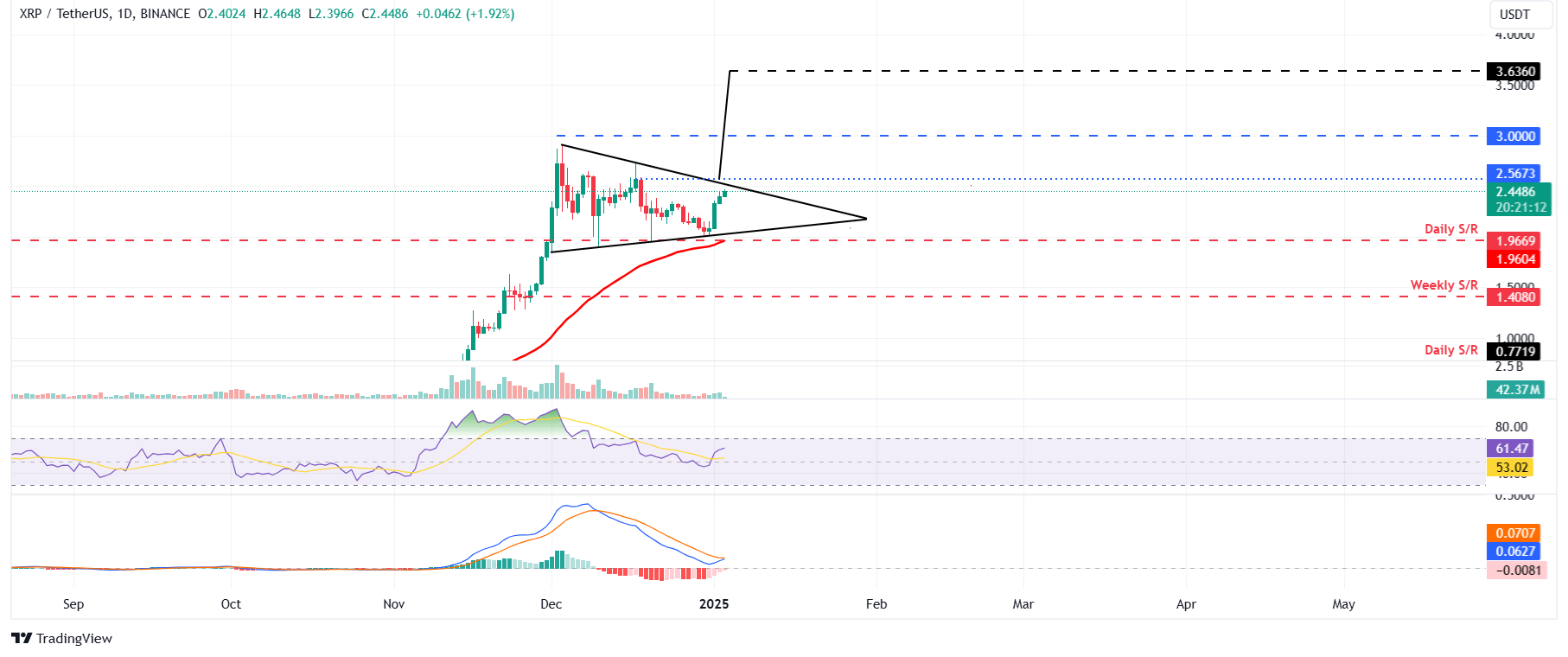Top 3 Price Prediction Bitcoin, Ethereum, Ripple: BTC, ETH and XRP eyes for a rally
- Bitcoin price bounces off the key support level of $92,606, suggesting a recovery on the cards.
- Ethereum price approaches its upper consolidation level of $3,522; a firm close above would signal a bullish trend.
- Ripple price could rally if it breaks above the upper symmetrical triangle boundary.
Bitcoin’s (BTC) price finds support around its key level, while Ethereum’s (ETH) price is approaching its key resistance level; a firm close above it would signal a bullish trend. Ripple (XRP) price trades within a symmetrical triangle on Friday, a breakout from which could signal a rally ahead.
Bitcoin bulls aim for the $100,000 mark
Bitcoin price found support around the 61.8% Fibonacci retracement level of $92,606 on Monday and rose 4.5% in the next three days. This level roughly coincides with the 50-day Exponential Moving Average (EMA) at $93,588, making it a key reversal zone. At the time of writing on Friday, it trades at around $97,000.
If the $92,606 level continues to hold as support, BTC will extend its rally to retest its key psychological importance level of $100,000. A successful close above it would extend an additional rally to retest its December 17, 2024, all-time high of $108,353.
The Relative Strength Index (RSI) on the daily chart reads 51, above its neutral value of 50 and points upwards, indicating a rise in bullish momentum. Additionally, the Moving Average Convergence Divergence (MACD) indicator on the daily chart is about to flip a bullish crossover. If the MACD (blue line) crosses over the signal line (orange line), it will give buy signals suggesting an upward trend.

BTC/USDT daily chart
However, if BTC closes below the $92,606 level, it would extend the decline to retest its key support level at $90,000.
Ethereum price consolidates between $3,245 and $3,522 range
Ethereum price consolidates between the $3,245 and $3,522 ranges after finding support around its 50% price retracement level of $3,245 on December 23, 2024. At the time of writing on Friday, it trades around $3,461, approaching its upper consolidation level of $3,522.
If ETH breaks above the $3,522 level, it would extend the rally to retest its psychological importance level of $4,000.
The RSI on the daily chart reads 48, below its neutral value of 50, suggesting indecisiveness among traders. However, like Bitcoin, the MACD indicator is above to flip a bullish crossover on the daily chart, signaling an upward trend on the horizon.

ETH/USDT daily chart
Conversely, if ETH breaks and closes below $3,245, its lower consolidating band, it would extend the decline to retest its next support level at $3,000.
Ripple price shows potential for upward momentum
Ripple price trades inside a symmetrical triangle, a technical pattern formed by connecting multiple high and low levels with two converging trendlines (from early December to early January). This technical pattern has a bullish bias, and the target is generally obtained by measuring the distance between the first swing high and the first swing low to the breakout point. As of Friday, Ripple trades at $2.45, approaching the triangle’s upper trendline.
Assuming the breakout happens by closing a daily candlestick above the daily resistance level at $2.56, the technical target obtained by this pattern would be $3.63. Investors should be cautious of this theoretical move as it could face a slowdown after a 17% rally to retest Ripple’s psychological importance level of $3.00 as traders could opt to book profits.
The RSI indicator reads 61 above its neutral value of 50 and points upwards, indicating a rise in bullish momentum. Like Bitcoin and Ethereum, the MACD indicator is above to flip a bullish crossover on the daily chart, signaling an upward trend on the horizon.

XRP/USDT daily chart
On the other hand, if XRP closes below the $1.96 daily support level, it would extend the decline to retest its next support level at $1.40.
Bitcoin, altcoins, stablecoins FAQs
Bitcoin is the largest cryptocurrency by market capitalization, a virtual currency designed to serve as money. This form of payment cannot be controlled by any one person, group, or entity, which eliminates the need for third-party participation during financial transactions.
Altcoins are any cryptocurrency apart from Bitcoin, but some also regard Ethereum as a non-altcoin because it is from these two cryptocurrencies that forking happens. If this is true, then Litecoin is the first altcoin, forked from the Bitcoin protocol and, therefore, an “improved” version of it.
Stablecoins are cryptocurrencies designed to have a stable price, with their value backed by a reserve of the asset it represents. To achieve this, the value of any one stablecoin is pegged to a commodity or financial instrument, such as the US Dollar (USD), with its supply regulated by an algorithm or demand. The main goal of stablecoins is to provide an on/off-ramp for investors willing to trade and invest in cryptocurrencies. Stablecoins also allow investors to store value since cryptocurrencies, in general, are subject to volatility.
Bitcoin dominance is the ratio of Bitcoin's market capitalization to the total market capitalization of all cryptocurrencies combined. It provides a clear picture of Bitcoin’s interest among investors. A high BTC dominance typically happens before and during a bull run, in which investors resort to investing in relatively stable and high market capitalization cryptocurrency like Bitcoin. A drop in BTC dominance usually means that investors are moving their capital and/or profits to altcoins in a quest for higher returns, which usually triggers an explosion of altcoin rallies.



